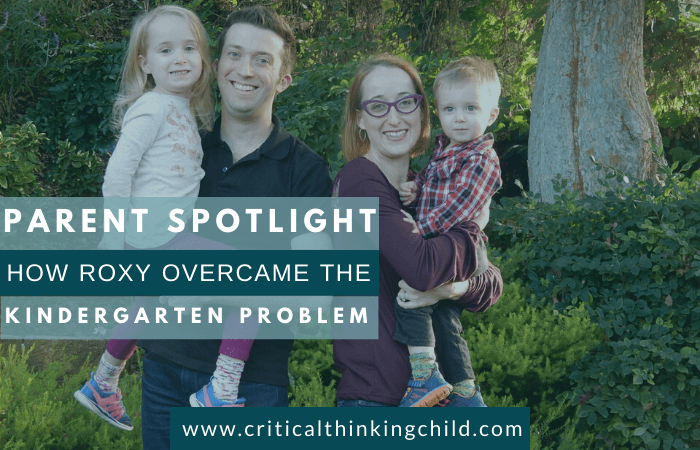Recently, we had the privilege of sitting down with Dave Urlakis and Beth Wolf, who told us how the Critical Thinking Child (CTC) helped their five-year-old daughter Roxy.
As self-proclaimed nerds, education has always been important to Dave and Beth. They are personally invested in STEAM (Science, Technology, Engineering, Arts, and Math) education and want to share that love with their children. They are also both big readers and read to their children regularly.
Naturally, Dave and Beth both want Roxy to receive the best education possible. That includes starting school as prepared as possible. But their natural love for STEAM didn’t tell them what specific skills Roxy needed to learn, and it didn’t give them the tools to monitor her success in mastering them.
When it came time for formal schooling, Dave and Beth wanted to prepare Roxy
With kindergarten looming, Dave and Beth weren’t sure how to get Roxy ready for formal schooling. “When it came time to prepare Roxy for kindergarten, we didn’t really know what we were supposed to be doing,” Dave shares.
They already had the passion, but they needed direction – and they needed it to fit their busy schedules. Their desire for guidance led them to The Critical Thinking Child, where they found tools and resources that allowed them to help Roxy cultivate a love of learning.
“When we started working with CTC, it was like a huge door opening for us,” Beth recalls. “Suddenly, we were receiving concrete information about what we could work on with Roxy and ways to approach it.”
Through their work at CTC they received invaluable tools to help their child thrive
Through the workbooks and resources at CTC, they helped prepare Roxy for the new words she’d be learning in kindergarten. “We are experts in Roxy, but we aren’t experts in early childhood education,” Dave tells us. “We would read with her, but didn’t know how to prepare her for kindergarten or kindergarten testing.” They learned how to montitor her academic success and determine whether she was truly mastering the skills being taught.
Dave and Beth first sought for help to solve what they call “the kindergarten problem.” They didn’t know where to send Roxy or how to make sure she received a good education. They wanted her to function well at school, but also solve problems in the world around her. What they didn’t realize was that the skills they could help Roxy learn extended far beyond kindergarten.
Before CTC, Beth says, they didn’t even have the vocabulary to say, “We need to develop critical thinking skills.” They simply hadn’t thought about it through that lens.
Now, after a year with CTC, Roxy can problem solve and synthesize information. She has learned her letters, how to read, and new math skills. “It’s more than I expected my five-year-old to know,” Beth confides. “She can put information together, which will help her not just in kindergarten, but all the way through school and into adulthood.”
Roxy received an education tailored to her specific academic needs
Dave also shares that, “We received a framework for spending productive time focusing on education and critical thinking skills at home.” They were able to tailor it specifically to Roxy by identifying areas she still needed help. Even better, the activities they learned were easy to incorporate into their lives, and fun for Roxy and her parents. Beth notes that, “every child is coming with different skills and strengths, so that tailored approach is so important.”
Dave and Beth got feedback from Lemi and her team and focused on specific goals for Roxy at home. Rather than simply memorizing numbers, they taught Roxy how a number line works and how to think about not just the shapes of numbers, but the value. They used tools like number lines and groups of dots to help Roxy develop a holistic understanding of math. Dave likes this approach because “you’re teaching your child how to look at the world around them and put those things together to have a meaningful understanding.” This is far different from the typical approach of rote memorization of numbers.
In terms of reading, CTC provided Dave and Beth with the Dolch sight word list, which is a list of commonly used words students need to know how to read and write in school. In addition to sight words, Roxy learned letter recognition and the letter sounds, which helped her sound out new words on her own.
Thanks to the Critical Thinking Child, Roxy learned to love learning
Where would Roxy be without the CTC? Dave isn’t sure, but he knows that she would not be a kid who can just pick up chapter books and read them all. Beth also confides that Roxy likely wouldn’t be attending her current kindergarten without the test prep provided by the Critical Thinking Child.
Beth admits that they weren’t sure what to expect with testing, but Roxy tested well for selected enrollment. In fact, she was placed in a regional gifted center as a result of her test scores. Beth shares, “She starts in a couple weeks and she’s really excited.”
Dave and Beth now approach education not as just as an exercise in learning facts, but as an opportunity to introduce a problem or experiment that Roxy can think about critically. They feel that they can be more productive at home now that they have a foundation to build from.
They also share that their work with CTC has impacted the whole family. Their two-year-old has seen Roxy learn and now wants to learn his letters and numbers.
Their final words about the Critical Thinking Child? “We’re very thankful. CTC has done so much for us!”
If you want to support your child in preparing for academic success, just like Beth and Dave did for Roxy, reach out to The Critical Thinking Child today.



